| Thank you for staying connected with EnviroConnections by Maricopa County Environmental Services Department.
This newsletter will be available quarterly and on special occasions. Get all the issues! If you are not yet subscribed, you can sign up now and  this with a friend. this with a friend.
By Steven J. Goode, REHS / Director
 |
|
In 2017, the Environmental Services Department is looking forward to continue working in collaboration with all members of our community towards the goal of another successful year of ensuring a safe and healthy environment. |
Environmental Services truly
believes that the County’s vision of “Citizens serving Citizens” is what we embody
daily. The mission of the Environmental Services Department is to
provide safe food, water, waste disposal and vector borne disease
reduction controls to the people of Maricopa County so that they may
enjoy living in a healthy and safe community. We promote public
safety for the over 4 million citizens and the thousands of
visitors to Maricopa County.
We begin to accomplish this mission
through our various regulatory activities. However, input from the community, through stakeholder meetings and other community partnerships, enhances our ability to stay in touch with the needs of the County.
Environmental Services is a
multi-national award winning organization which endeavors to offer
outstanding customer services, cutting-edge programs and processes, transparent and open communications; all characteristics which are
demanded by our community. We take a great amount of pride in being proactive to our citizens and community leaders.
Thank you for your continued interest, public health dedication and collaboration with the Maricopa County Environmental Services Department.
 More Updates & Information coming your way!
This year watch out for more
notifications of our Enviro~Connections newsletter and Alerts. As you know, the Enviro~Connections newsletter has been sent out electronically quarterly, and when pertinent you’ve seen
some special mini-editions or Alerts with just one or two topics with updated information or announcements.
We’re committed to keeping you informed about department-related
happenings that may affect you and the public in general. Our goal is to continue to maintain this flow of information with great efficiency and very timely.
Whenever you see an Enviro~Connections ALERT make sure
to open the Link attached in the email with the ALERT so you can be up-to-date
with the Department's announcements (e.g. changes or reminders in policies, procedures or
any other pertinent update, news) and/or any piece of information or educational material that may help
you in your business.
Your feedback is also encouraged and welcomed (ESD@mail.Maricopa.gov).
Environmental Services Department's goal is to keep the stakeholders/public Enviro~Connections newsletter relevant and to assist in keeping the community connected
and updated through our special Enviro~Connections ALERTS.
Back to Top
|
 Partnering for Better Business
On Tuesday May 23, 2017, Environmental Services Department and other Maricopa County permitting agencies will be conducting the 1st Annual Permitting Conference.
Operators that may have multiple county permits will have the opportunity to hear from the different department directors and representatives. There are panels and presentations being scheduled to help you better understand the different requirements and needs to help you with your applications and to expedite your permits for a smooth process and better success.
Air
Quality, Flood Control District, Planning
and Development, County Department of Transportation and Environmental Services
Departments are joining forces to bring you this all-day Permitting Conference
on Tuesday, May 23rd.
Stay tuned for more
information and details regarding registration and the event's topics/presentations, coming soon!
Back to Top
|
By Bryan Hare, Environmental Health Division - CRO Managing Supervisor
The Maricopa County Environmental Services Department,
Environmental Health Division works closely with stakeholders to ensure that
food and beverages served at restaurants are safe for the citizens in Maricopa
County. This partnership requires open communication, engagement, and
professionalism from both parties. There may be times when disagreements arise,
but it should never lead to behavior that interferes with staff in the discharge
of their duties by way of verbal or physical interference. To expand on this,
using offensive language, yelling, intimidation, or any other unprofessional behavior
toward our staff will not be tolerated and is considered interference with the
inspection. It is never acceptable to
threaten or physically harm another person.
Chapter 1, regulation
7b (1) of the health code states, “The Department may revoke a permit
for two or more violations of this Environmental Health Code, for any violation
that threatens the health or safety of the public, for the nonpayment of a fee
or for any interference with the Department’s performance of its duties, the
inspection of an establishment, premises, or vehicle, or the enforcement of
this Environmental Health Code.
 Whether someone is frustrated with the findings of an inspection report or just having a really bad day, it is important to understand that professionalism is the expectation for our staff, stakeholders, and the citizens we serve. To avoid confrontation, it is recommended the aggressor(s) remove themselves from the scene until they’re able to reach self-control and their emotions no longer present a threat to the inspector. We have a knowledgeable inspection staff who are willing to help with any food safety challenges that may arise by educating and collaborating with everyone involved. If you as the operator feel you are being treated unprofessionally, or don’t agree with the inspection findings, you have the right to respectfully contact the Department. The Environmental Health supervisor or manager can be contacted through email or by phone – supervisor’s name and phone number are located at the bottom of every printed inspection report. An operator may also request the inspector mark an inspection for “supervisor review.” This will trigger an email be sent directly to the inspector’s supervisor who will then contact the operator. The inspection will be put on hold until after the supervisor speaks to the operator. Our Department has language liaisons (Spanish and Chinese) that can assist with language barriers as well. If the establishment’s ownership needs to be contacted by our Department, management will make the necessary arrangements and often times schedule a face-to-face meeting to resolve any issues.
It’s extremely important that we all use our emotional intelligence when interacting with each other for positive professional outcomes and success. “Emotional intelligence is the capacity to be aware of, control, and express one’s emotions, and to handle interpersonal relationships judiciously and empathetically,” (Emotional Intelligence 2016). Professionals who control their emotions and don’t let their emotions control their behavior earn the respect of those with whom they interact.
"Emotional Intelligence." Emotional Intelligence. N.p., n.d. Web. Oct.-Nov. 2016. <https://www.google.com/?gws_rd=ssl%20-%20q=emotional+intelligence+definition#q=emotional+intelligence+>.
Back to Top
|
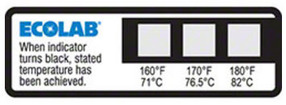 |
By Jon Tran, REHS/RS / Training Liaison, Quality and Compliance Division
Sanitizing is important. Due to the high volume of food that most facilities put out and how dishes are used repeatedly, sanitizing provides an extra safeguard beyond only using soap and water. Sanitizing utensils, kitchen equipment or any food contact surface in your foodservice facility is an essential task in reducing food safety risks. This article will be going over important information that pertains to testing a sanitizer that you might be using in your facility—heat.
When sanitizing, most operations use either low-temperature or high-temperature sanitizing methods. Low-temperature methods sanitize your food surfaces via a chemical method (chlorine, iodine, or quaternary ammonia). High-temperature methods involve heating up your utensils (usually in a dish machine) and other surfaces to high enough temperatures to kill harmful pathogens. For both of these methods, testing the sanitizer should be an integral part of a food safety system. Low-temperature chemical methods are usually tested with specially formulated testing papers. High-temperature methods of sanitizing, however, might be slightly more involved.
To properly sanitize a food contact surface using high temperature, the surface in question must reach at minimum 160°F (4-703.11 (B)). Testing for this temperature requirement at your establishment can be done using two types of tools: an irreversible registering thermometer (sometimes called a min-max thermometer) or heat sensitive strips.
 An irreversible registering thermometer has a setting where the highest temperature registered in a given timeframe can be measured and locked into the thermometer’s memory. To use this tool correctly, you should take a few things into consideration:
· Ensure your thermometer is properly calibrated (32°F in an ice bath)
· Clear out your thermometer’s internal memory
· Position the thermometer properly in the machine (around where dishes receive direct contact from the water jets)
Once you’ve checked all the above items, send the thermometer through the dishwashing cycle. If the temperature read out is 160°F or above, your machine is sanitizing according to code requirements.
Your chemical company might also supply you with heat sensitive strips that change to a certain color once your dishware heats up to 160°F. To properly use these strips you should consider the following:
· Position the strip on dishware that would take the longest to heat up (something plastic or ceramic)
· Make sure to stick the strip onto a piece of equipment completely. For instance stick the strips to a ceramic plate instead of wedging strips in between fork tines. The strip is meant to measure the plate surface, not the water temperature hitting the strip.
If the strip turns the correct color, then your machine is sanitizing according to code requirements. If your strip doesn’t change colors or if there are discrepancies between water temperatures measured via a thermometer and a test strip you may want to have a look at some of these possible contributing factors:
· Have the strips been exposed to sunlight or high temperatures beforehand? The strips have a storage temperature recommendation of 80°F or below.
· How old are the strip? The shelf-life of these strips are 2 years under recommended conditions.
· Do you have the right strips for the job? There are some strips that are manufactured to change color at 180°F rather than 160°F.
For more information on sanitizing code requirements please refer to the 2013 FDA Food Code or call your Maricopa County Environmental Services inspector. Your chemical and dish machine provider can also provide information on how your particular dish machine model works.
Back to Top
|
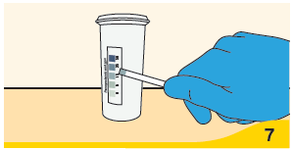 By Mike Britt, RS/REHS, CPO / Training Liaison Senior, Quality & Complaince Division
Ecolab is marketing this chemical
sanitizer product to be used in commercial dish machines. It is a peroxide based
sanitizer and is compliant with 2013 US Food Code sections 4-501.114 and
7-204.11, and acceptable for use as directed on the products label. Ingredients
in CSR (active and inert) have been reviewed and are considered cleared for
food contact surfaces for use in food contact antimicrobial pesticide products.
The active ingredients are peroxyoctanoic acid and hydrogen peroxide. As a
sanitizer, CSR is registered with the Environmental Protection Agency (EPA) for
use on pre-cleaned, hard non-porous surfaces. CSR was approved by the EPA for
use as a food contact sanitizer against Staphylococcus aureus and Escherichia
coli with the appropriate data submitted in support of these claims.
|
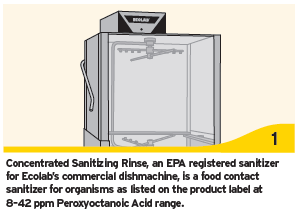 Anytime this chemical would be in use at an establishment dish machine, a chart explaining how to use and test chemical concentration should be readily available to employees and inspectors alike. In order to test for the proper amount of active chemical in the dish machine, provided test strips should be utilized. For this chemical, the correct concentration test strips should be in available supply at the establishment at all times. Peroctanoic Acid test strips must be used for this test; standard chlorine test strips should not be used and will not work. Ecolab’s Concentrated Sanitizing Rinse is registered for use between 8 and 42 PPM and instructions for testing are available at the point of use.
|
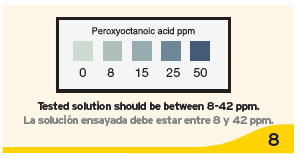 For decades the most common chemicals we have seen in commercial use are chlorine (bleach), quaternary ammonia (QUAT) sanitizer, or also iodine solutions. This now adds another possible sanitizer type that may be seen in use at establishments in Maricopa County.
|
 |
|
Please contact an Ecolab representative or 1-800-35-CLEAN for further information.
Back to Top
|
 The Environmental Services Dapartment's Mobile Restaurant Ratings "app" was recently featured in the Fall 2016 edition of ArcNews. This article is a national recognition of the mobile version of our Restaurant Ratings tool. This application allows customers to easily access on their electronic device the different Maricopa County food inspection reports, the food establishments 'near me', as well as those food businesses that are participating in our food safety active managerial control A+ program "The Cutting Edge".
Thanks to Environmental Health Management Analyst Tisha Taylor for making this national article happen, and kudos to our great photo-models, Environmental Health Specialists McKenzie Ricca and Daniel Markstrom, for being such good sports and for helping us with this project!
About ArcNews
The ArcNews publication reaches more than 750,000 people who are interested in GIS technology. 75% of their software is used by Fortune 500 companies and the rest is national and local governments, public utilities and tech start-ups around the world. Over 350,000 organizations worldwide rely on Esri software and Esri has 41 offices in 67 different countries. They also work in areas that assist in conservation, education and humanitarian aid.
Here’s the link to the article:
http://www.esri.com/~/media/Files/Pdfs/news/arcnews/fall2016/fall-2016.pdf—we are on p. 28
Visit our
Website: ESD.Maricopa.gov or Click (https://envapp.maricopa.gov/EnvironmentalHealth/Mobile)
to easily access our Restaurant Ratings from Mobile Devices (you can download
it and save it to your cell phone or tablet’s desktop)
Back to Top
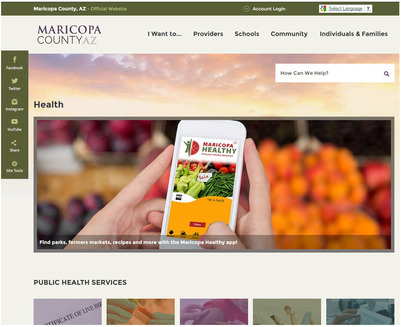 Maricopa County will officially launch its new
website next month!
This new website will continue Maricopa County’s transformation as a leader and
innovator in the region, offering a more customer-friendly experience to make
it easier than ever to do business with the County in general and with the Environmental Services Department.
Back to Top
 Follow Us, Like Us, Watch Us and More!
Maricopa County Environmental Services department is constantly working to make effective use of social media. You can subscribe to our YouTube channel, connect with us on Facebook and Twitter, and now also on Pinterest!
Back to Top
|
|